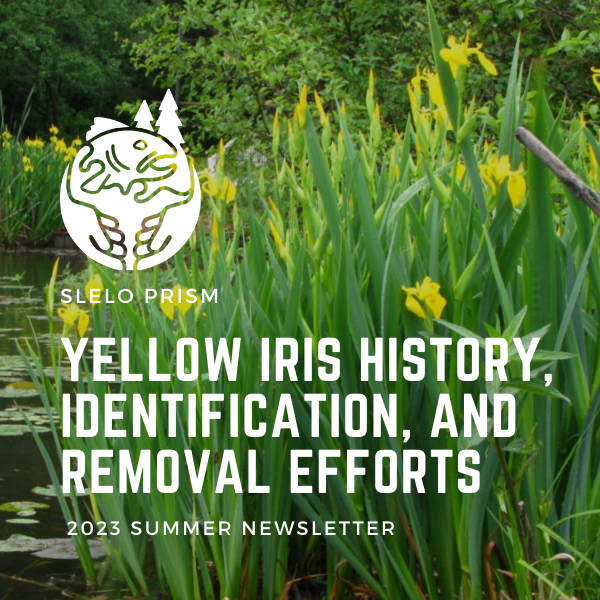This article was featured in the 2023 summer newsletter by Rachel Rowlee SLELO PRISM/TILT Watercraft Inspection Steward.
Yellow iris (Iris Pseudacorus) is a flowering plant native to North Africa, Europe, and Asia, that is identifiable by its bright yellow flower, which led to its popularity as an ornamental plant. Since it’s introduction in the late 1700s, the popularity of the yellow iris throughout history has contributed to its continued spread.
Yellow iris can be identified visually by its showy yellow flower and flat swordlike leaves that have a bluish tint. If you are unsure in your identification, the mid vein of the leaves is very prominent and can be felt. Additionally, the plant has orange to pinkish meaty colored rhizomes, which can be identified by looking at a cross-section. When yellow irises have not yet bloomed, they can be mistaken for native blue flag irises. Blue flag irises are native shoreline stabilizers, therefore, taking extra effort to identify yellow irises is essential. Removal can be done by digging the entire rhizome and all connected rhizomes to prevent regeneration.

Yellow iris outcompetes native species vital to the health of riparian and wetland habitats. They are also known to be toxic to livestock and are not considered to provide a food source for insects. Yellow iris seeds float and can easily spread through waterways. Yellow iris have rhizomes and their networks create a positive feedback loop in environments, as sediment becomes denser, more yellow iris grow. The dense sediment becomes a more ideal habitat for trees and shrubs, creating drier shorelines and nesting habitats for waterfowl and fish are altered/disrupted. (USGS.gov).
Yellow iris is deemed a high-risk invasive species in the New York State Invasive Species Tiers, indicating that management and intervention measures to prevent the spread of the yellow iris are important. SLELO PRISM ranks yellow iris as a tier-three species, which is defined as needing targeted management to suppress the population in priority areas.
To enhance target management efforts, on June 8th, 2023, SLELO PRISM hosted a yellow iris hand-pull event for New York Invasive Species Awareness Week (NYISAW). Approximately 300 yellow iris were removed from the shore of the South Colwell Pond at Montario Point in Ellisburg, New York, which is within the NYS DEC Lakeview Wildlife Management Area. In addition to Montario Point, removal efforts for yellow iris occurred at Black Pond WMA and El Dorado Preserve, totaling to over 800 plants removed in the SLELO Region this summer!
These removals raised awareness and helped to reduced the dense sediment that had developed due to the thick rhizome network of the yellow iris. This will enhance the overall health of these riparian areas and allow the native plants and wildlife to reclaim the habitat. If you find yellow iris please report it to NYiMapInvasives.org.








